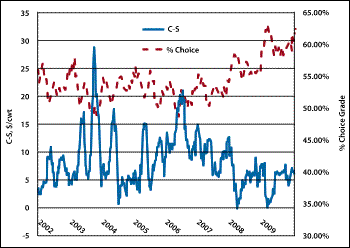What the Choice-Select
Spread is Trying to Say
Premium Choice now carries the banner for quality beef.
Cattle are sold by the pound, but the price per pound can make as much difference as total weight when it comes to the bottom line. That's why producers who aim for profit weigh everything that goes into that price.
The Choice-Select spread has been a leading indicator for decades, but a current analysis suggests it can mislead if taken at face value. A lot more commodity Choice came on just as the economy was closing the menu on "middle-meat" steaks cut from that commodity pool, which no longer represents much of an advantage over Select.

Mark McCully
Producers today must lift their gaze to the relative values of premium Choice and Prime beef if they want to monitor the market, says Mark McCully, Certified Angus Beef LLC (CAB) assistant vice president for production.
McCully recently published a white paper entitled, "Trends in the Choice-Select spread and implications to cattle producers." He explains that spread is simply the difference in price between the boneless beef cutout from a USDA Select carcass and one that graded Choice.
"But the difference may not be as simple as it first seems," he adds. "Most of the upper two-thirds Choice beef is committed to premium branded programs, and much of the low-Choice product is also branded. That means it is separate from the USDA-reported price, which is now derived from the 'leftovers,' a little more than 15% of all Choice-grade cattle."
Why is that an issue? Traditionally, the market relied on the published Choice-Select spread as a barometer and a price-discovery point in value-based marketing, McCully says. More than 60% of fed cattle today sell on some type of grid, formula or other method based partly on this spread.
In the last decade, the Choice-Select spread has been wider than $20 to slightly negative for a few weeks (see Table 1). On average, marketers have assumed that a spread greater than $8 per hundredweight (cwt.) means strong demand for high-quality beef. On the other hand, a spread of less than $3 per cwt. was thought to signify weaker demand for quality.
| Table 1: Annual Choice-Select spread average and ranges | |||||||||
2002 |
2003 |
2004 |
2005 |
2006 |
2007 |
2008 |
2009 |
Avg. |
|
| Avg. | $6.10 |
$11.60 |
$6.85 |
$8.46 |
$13.49 |
$9.28 |
$5.17 |
$4.70 |
$8.21 |
| High | $10.98 |
$28.90 |
$17.69 |
$15.09 |
$21.09 |
$13.61 |
$10.86 |
$8.07 |
$15.79 |
| Low | $2.29 |
$3.80 |
$0.56 |
$2.67 |
$8.59 |
$5.48 |
(0.19) |
$0.01 |
$2.90 |
| Range | $8.69 |
$25.10 |
$17.13 |
$12.42 |
$12.50 |
$7.28 |
$9.81 |
$8.06 |
$12.89 |
"Those assumptions don't consider all factors in the equation," McCully points out. They don't take into account the quantity or the makeup of Choice. Not only is commodity Choice less worthy of a premium over Select, but there has been a rapid increase in its supply (see Fig. 1). USDA reports show the percentage of fed cattle grading Choice has trended higher for nearly four years.
Fig. 1: Historical relationship between the weekly Choice-Select spread and % Choice grade
It's no coincidence that the Choice-Select spread also has been on a declining trend since 2006. But that doesn't mean consumers are turning away from highly marbled beef, McCully stresses.
Correlation analysis suggests the sole demand drivers of the Choice-Select spread are the Choice rib and loin prices. And for the past two years, an economic recession has curtailed dining out at the mid-level restaurants that feature such cuts.
Select cutout values since 2002 have had essentially no effect on the spread. "That tells us a narrow Choice-Select spread does not point to more demand for Select beef," McCully says.
Indeed, consumer demand is chiefly linked to high-quality beef. A study last year by beef industry consultant Julian Leopold found that the combination of Certified Angus Beef ® (CAB®) brand price and volume showed at least a 27% demand advantage over USDA Choice since 2005.
Since then, demand has more than kept pace with record supplies of cattle that qualify for the brand, up more than 20% for the first six months of the CAB fiscal year that began Oct. 1, 2009.
 "If producers look only at the Choice-Select spread, they may venture down a familiar road that led to overall long-term weaker demand for beef 30 years ago," McCully cautions. "Look at the next level. USDA reported last year that a premium Choice carcass was worth $8 per cwt. more than Select and the Prime premium was double that. On an 800-pound carcass, that's $65 to $130 more per head."
"If producers look only at the Choice-Select spread, they may venture down a familiar road that led to overall long-term weaker demand for beef 30 years ago," McCully cautions. "Look at the next level. USDA reported last year that a premium Choice carcass was worth $8 per cwt. more than Select and the Prime premium was double that. On an 800-pound carcass, that's $65 to $130 more per head."
Numerous studies continue to indicate consumers buy beef because of the taste, and nothing delivers that better than marbling. As the world's economies recover, mid- to upper-tier restaurant business is poised to recover, along with demand for high-quality steaks. Moreover, the recession and lower Choice-Select spread saw many retail stores trade up to higher-grading beef.
The U.S. beef global trade advantage comes from its grain-fed and high-quality nature, McCully notes. Growing international market access and stability will further support demand for Choice and higher-quality beef.
For a complete copy of the white paper, visit http://www.cabpartners.com/news/research/





